Categories: Sockets and switches
Number of views: 120837
Comments on the article: 1
Types and types of light switches
An article on electrical wiring for a home master met on the Internet. In it, the author wrote that zero and a network phase are supplied to a conventional household lighting switch. This erroneous statement can mislead an inexperienced person, lead to a short circuit in the wiring.
Any apartment switch is always mounted in the phase wire break according to the following scheme.
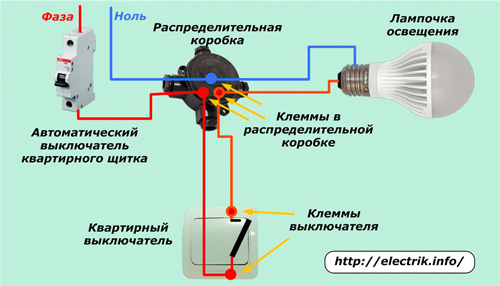
How to properly connect the lamps through various light switches is described in detail in this article:Schematic and wiring diagrams of lighting in an apartment and a house
For home lighting, switches of various designs are used. All of them relate to switching devices with two positions of the working body that determine the following boundary states:
1. open circuit;
2. supply voltage to the lamp.
Lighting control in most cases is performed manually. Housing switches are designed to work in home wiring at rated network parameters and are not designed to trip excess currents and short circuits.
This protective function is carried out by the automatic switches of the apartment panel, which are equipped with current releases, cut-off mechanisms and arc extinction systems.
Any model of a light switch is created for certain technical tasks:
-
working current;
-
mains voltage;
-
Climatic performance;
-
degree of dust and moisture resistance (IP-code);
-
installation method;
-
wire fastening;
-
switching method;
-
type of management and other purposes.
In the vast majority of designs, the wires are connected to the terminals with a variety of screw terminals. This method has passed the test of time. Now, to facilitate installation, they have become popular spring-loaded terminal blockswhich allow faster installation by inserting the conductor end into the clamping device.
Light Switching Methods
Housing switches can be controlled:
-
by pressing a key;
-
toggle switch;
-
pulling or releasing the cord (chain);
-
moving the slider;
-
turning on the button;
-
built-in motion sensor;
-
touch panel
-
the intensity of the incident light flux;
-
remote control.
They are most often mounted on a wall for outdoor or indoor wiring.
With a hidden placement method, the switch is hidden in a socket inside the wall, and the wires are connected to the terminals after fixing the case. For open wiring use a sock. The base is fixed to it with screws.
Keyboard Constructions
Structurally, the light switch, controlled by pressing a key (toggle switch), consists of contacts fixed in the housing and a movable swinging mechanism, pressed by a spring operating on:
1. compression;
2. stretching.
In the first case, the pressure exerted on the key is transmitted to the ball compressing the spring. He slides along the swing axis of the rocker arm, rolls over his shoulder and moves the movable mechanism with contacts in the opposite direction.
In the second method, a frame is attached to the switch button, pressed by the spring to the base. It sways around its axis and with its movement creates or breaks an electrical contact.
In both cases, the movable part under the action of the spring switches the switch from one state to another, depending on where you press the lower or upper part of the key.
Common types of such switches and internal circuits of the contact system are shown in the picture.

With correctly selected electrical parameters and observing the operating mode, the circuit breaker can work without fail for many decades. As an example, below is a picture of an old half-century old single-lever keyboard model, which, despite the dustiness, cobwebs and the effect of atmospheric moisture (corrosion of screws and washers of copper wires fastening is clearly visible), has remained operational to this day.
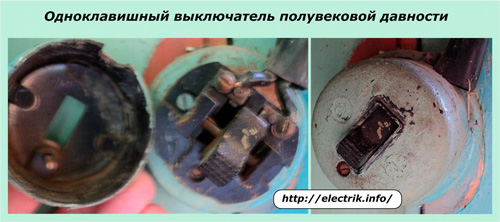
This switch worked in an unheated wooden veranda-annex to a private house with virtually no maintenance. Of course, the quality of its design does not meet modern requirements. But, insulation from the wall with a dielectric socket, a sturdy plastic case and a design for external mounting that meets the requirements of the old GOST, completely ensured its long-term, reliable operation.
Inside the case, a spring-loaded movable jumper works, which commutes stationary contacts connected to the lighting wires. In the upper position, the jumper lever creates an electric circuit, and in the lower position it opens.
Cross over and passage switches
They are a kind of rocker type keyboard designs. When a key is manipulated, one of the two lamps connected to them lights up.
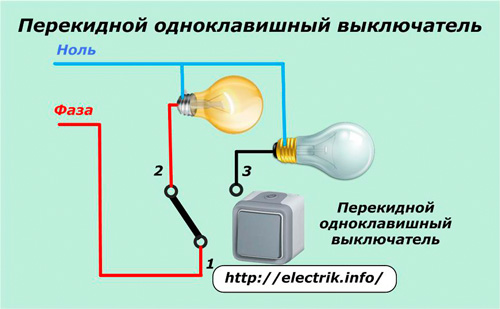
But such schemes for domestic lighting are practically not used. They are used in technical devices. Most often, such models are used to control the light from several remote locations. The simplest example of their use is shown in the picture below.

In this scheme, to simplify the understanding of the principle of operation, junction boxes for joining the ends of the cables are excluded.
According to this principle, it is possible to carry out inclusion of a lamp from three or more places, but you have to add a two-key rocker switch.
Cord switches
Another type of old outdoor mounting switch for ceiling mounting is shown in the following picture.
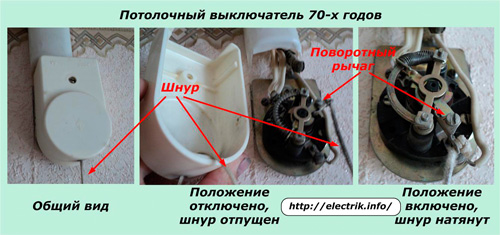
Such models were massively installed inside multi-storey panel buildings in the 70–80s. They, with proper operation, continue to work now. A feature of their device is a nylon cord hanging down from the housing, which is tied to a pivot arm fastened to a movable terminal block. The return of the pad is ensured by the compression energy of the spring after releasing the cord.
Among such models, there are designs that, by pulling the cord (turning the lever), control two groups of lamps for the chandelier: when the first tension is turned on, one block of lamps is turned on, when the second is pulled, the other, and then they are switched off sequentially.
Push-button devices
They can be found at the base of a table lamp, above which rises a button with a clip.
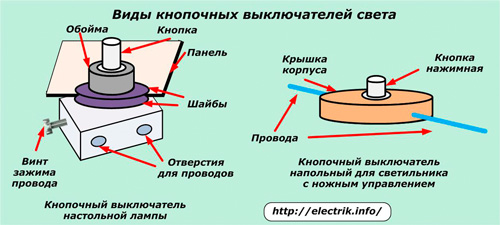
The cylindrical part of the switch at the bottom of the panel is led out through the technological hole. The prepared ends of the electrical wires are inserted into the sockets and clamped with screws from the ends of the housing.
In the same way floor models work for sconces.
The button of the table lamp can be made in an enlarged decorative form, convenient for use, as shown in the photograph.
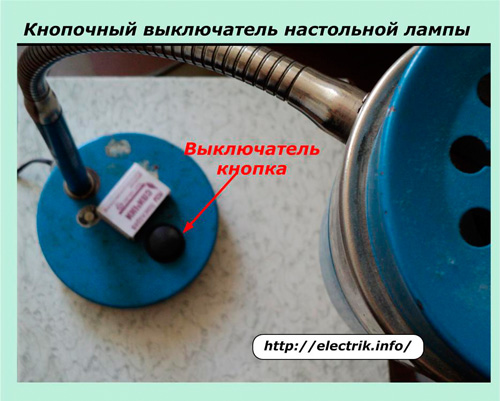
On the wall sconces push-button switches can be installed, the pressing of which is carried out by a spring-loaded lever through a fixed hanging cord or chain with a handle. An example of such a design is highlighted with a red frame in the image below.
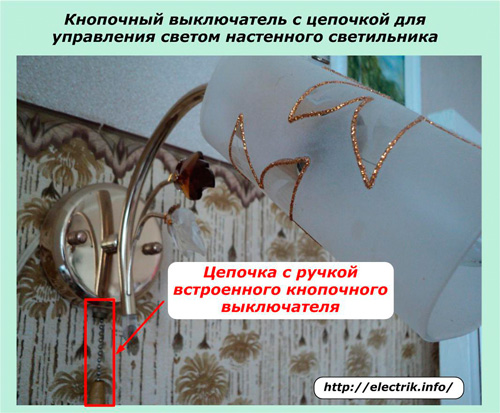
The push-button switches discussed above operate on the principle of a key, when the first time they are lit, the light is turned on and left on, and the second is turned off.
In practice, there are often buttons with a self-return spring, which create a current pulse (operation in the button mode without holding). To control the light using such devices, it is necessary to connect an additional relay circuit.
Slide Switches
In a closed case with fixed contacts, a movable mechanism with a contact bridge moves. The compression spring provides improved fixation and compression of the shifted pads to create good conditions for the passage of electric current.
The photo shows a table lamp with a slide switch and a picture with a section of the design of one of these many numerous models.

In it, the movable element is placed above the central part. Such a device provides a clear clamp for creating good electrical contact with minimal chance of sparking. This is a condition for ensuring long and reliable operation.
Touch switches
Such designs do not need mechanical action: they have a special panel on the outside, controlled by a simple touch of a finger. Similar models can be configured to work in key or button mode.

By their device, touch switches consist of:
-
a sensing element that responds to touch and sends a processing command;
-
an electronic circuit with semiconductor elements that perceives a command signal and converts it for perception by an executive body;
-
switching part, providing power switching.
Thanks to the electronic filling, they can be remotely controlled and equipped with additional sensor functions:
-
movement
-
temperature
-
illumination.
Motion Sensor Switches
Their design includes electronic components that perform continuous analysis:
-
the level of illumination of the controlled space;
-
the presence (or absence) of human movement in the sensor sensitivity zone.
Subject to the necessary conditions for the inclusion of light, the sensor is triggered.
A typical scheme for connecting a luminaire to such a device is based on connecting the supply phase to a separate terminal “L”, zero to “N”, and the outgoing phase “A” and the neutral conductor to the luminaire (click on the picture to enlarge).
If in practice there is a need for a certain time to block the operation of the motion sensor and use a conventional switch for lighting, then use the right scheme. It does not violate the normal operation algorithm when the switch is off. More details about the features of connecting the motion sensors of racazaon here: Motion Sensor Connection Diagrams
Twilight Switches
This design is based on the principle of a photorelay, which responds to changes in illumination with a special sensor. With a decrease in the luminous flux, such a switch independently turns on the lamp, which will burn until the external lighting increases.
For the economical operation of the luminaire, the twilight switches are supplemented with motion or presence sensors.
Remote Control Switches
They allow you to control the lamp from a distance through a small remote control, which is a transmitter that emits commands over the air. The switch itself is a receiver that, with its own switching contacts, cuts into the power supply cable of the lamp.
It can be installed directly near the chandelier mount, either instead of the old key switch or even inside the apartment panel.
To control energy-saving fluorescent or LED lamps, the switch will have to supply phase and zero for the power supply.
Depending on the transmitted command from the remote control, the light turns on or off. The range of the transmitter depends on the structure and materials of the building, and the average radiation power is sufficient to cover a distance of about 20 ÷ 25 meters.
It is enough to use ordinary batteries to power the remote control. Given the economical mode of operation, their life will be quite long.
The use of microprocessor controllers in the control circuit allows you to expand the functionality of the fixtures, smoothly start them, adjust the light intensity, use a timer and other mechanisms.
Sometimes it becomes necessary to move the switch to another location. Read how to do this in the article. "How to transfer the socket and switch".
See also at bgv.electricianexp.com
:

